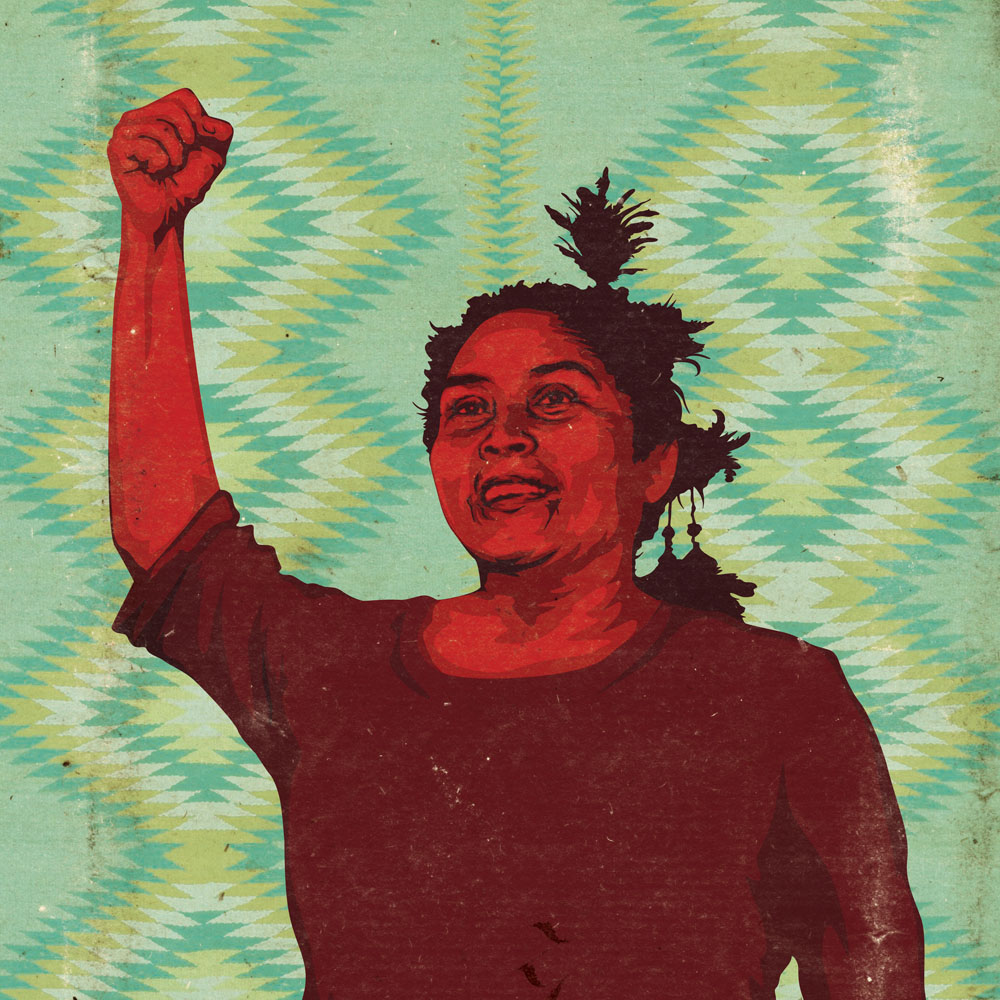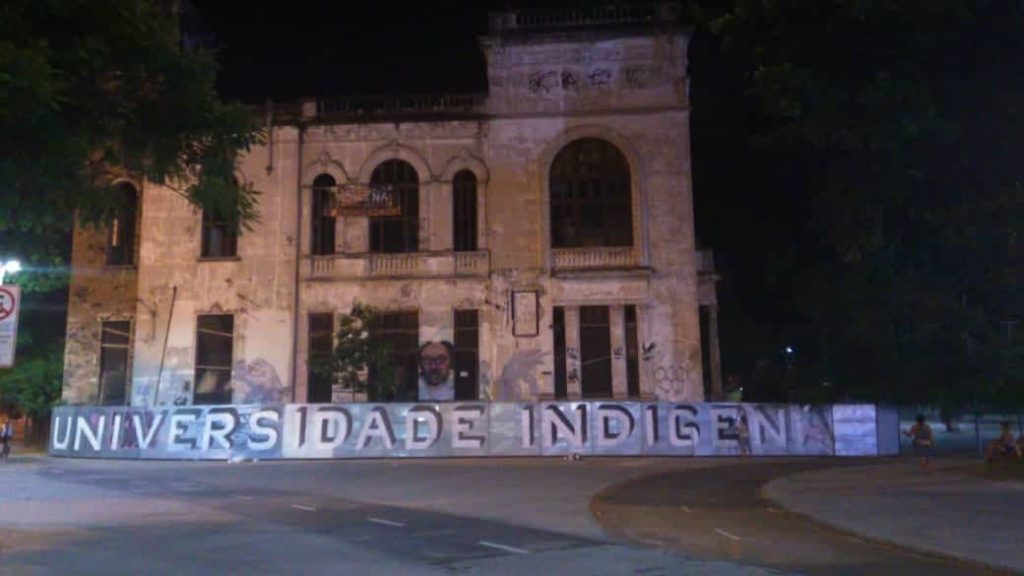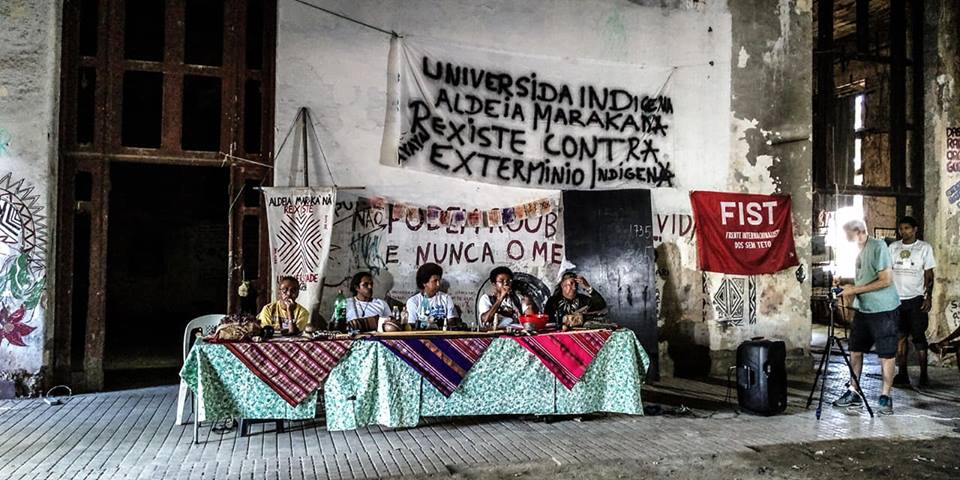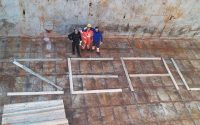Brazil // Aldeia Maraka’nà – Indigenous memory and history under attack~ 8 min

This text was written in collaboration with the Maraka’nà Village.
Aldeia Maraka’nà is an indigenous village located in an urban environment in the North Zone of Rio de Janeiro, next to the Maracanã Stadium, and on indigenous ancestral territory. The 1885 building where the village was settled has been under indigenous care since it was abandoned by the government of Rio de Janeiro State in 1978. Before that, the building became the first Native Protection Service (SPI) in the country and in 1953 it became the first Native Museum in Latin America, created by the anthropologist Darcy Ribeiro.
From 1950 to 1970 he also hosted a postgraduate degree in Anthropology from UFRJ. In 1978, the Latin American Native Museum was transferred to another part of the city and the building was abandoned.

30 years later, the city of Rio de Janeiro welcomed the First Tamoio of Native Peoples’ Congress, during which indigenous people of 17 ethnic groups, indigenists and indigenous supporters created a movement to take back and occupy the building forgotten since 1978. Thus began a movement of cultural resistance that became known worldwide as Maraka’nà Village.
Since it was established in 2006, the Maraka’nà Village serves as a community space run by indigenous people of different ethnic groups, either resident or in transit through the city of Rio de Janeiro. It is a space in which to fight for indigenous rights in Rio de Janeiro and to create conditions to enhance and cultivate the plurality of indigenous culture. It is in such context, in direct relation with the territory and its history, that the project of the Autonomous Indigenous University was created. This project serves to highlight and reinforce the importance of indigenous people in the creation of a more just and sustainable society. It hosts regular workshops on subjects such as Tupi-Guarani language courses, traditional construction workshops, cultivation and use of medicinal herbs, crafts and graphic design and soil maintenance.

At the Indigenous University of Aldeia Maraka’nà, knowledge is shared about the various ethnic groups that cohabit in the Village and colonization is deconstructed in order to valorize the way of life of the indigenous culture. The University applies teaching models that allow the sharing of socioenvironmental, economic, medicinal, scientific, philosophical and cultural knowledge. By establishing itself as a space within the city in which indigenous people from different states can preserve and transmit aspects of their way of life; the Maraka’nà Village offers society in general a real contribution when facing the exploitation of ecosystems – one of the most serious problems of our time.
The colonial relationship of oppression, invisibility and genocide of indigenous peoples is a constant one and there have been several attacks against Maraka’nà Village. Despite its fundamental role in the development and preservation of indigenous culture, the fact that it is located next to one of the mass entertainment industry poles in Brazil, makes it a very attractive building in the eyes of real estate speculation. So appealing that the Village was in danger of being evicted to give way to infrastructure for the 2014 World Cup events. It happened in 2013, during the preparations for the World Cup, when the government of the State of Rio de Janeiro tried to demolish the building that houses the Maraka’nà Village, to give way to the construction of the Maracanã Complex, that would serve as the stage for some of the World Cup games. The government’s decision generated controversy and indigenous and popular movements united and resisted. It was in order to resist that Jose Urutau climbed a tree in 2013 and stayed there for 26 hours in protest against the eviction of the Maraka’nà Village.
Former governor Sérgio Cabral eventually rescinded the decision to build the Maracanã Complex and even promised to create an Indian cultural center. This promise resulted in a judicial agreement in which the territory was attributed to the indigenous peoples of Maraka’nà for the creation and management of the Autonomous Indigenous University. The agreement is not being complied with and the indigenous people of Aldeia Maraka’nà are still awaiting the outcome of the judicial process that will allow them to take definitive possession of the land.
Meanwhile, the State of Rio de Janeiro filed a new eviction lawsuit. The action is full of illegalities, with the judges being replaced, one after the other, for considering themselves unfit to judge. This is allowed by law, but it reveals the political and economic pressures involved in this process, which is yet to be completed. There was even pressure for the process to end and the trial was scheduled for December of last year. But it was since postponed again on the basis of the illegalities pointed out by the presiding judge. This same judge, who showed interest in deciding in favor of the Village, opted to distance himself from the case – something which is allowed by law – on the basis of supervening and personal reasons. A suspicious action, if we think of the constant political attacks on the Village and threats of the building’s demolition and eviction of the families that live within.
The danger of eviction is therefore a constant threat. Private interests are applying more and more pressure and the State wants to guarantee at all costs that the land is vacated to allow the implementation of its capitalist projects. For this purpose, it resorts to several mechanisms to denigrate the indigenous identity of the Village, in order to get them expelled. Among these mechanisms is the use of mass media to spread a constructed false image of the indigenous peoples. Recently, Rodrigo Amorim of the Social Liberal Party, the party of the fascist President Jair Bolsonaro, made statements offending the indigenous population. Racist and hateful statements that refer to the people of the Village as “vagabonds” or “homeless” and accuse them of being the cause for the deterioration of the territory in which they live. The same territory that the Brazilian government abandoned for 3 decades.
All the cultural and educational activity that the Village has played host to is being ignored. The visits by several schools and the workshops in which the indigenous people teach about their experience and its relation to bioconstruction, ecologically conscious planting, the art of the loom, among others. All the work to maintain that territory alive is also being ignored. Whether through replanting, the preservation of its historical memories, through the organization of meetings and debates about the history of the Village, about indigenous language and cinema. Or through activities that encourage communication with other indigenous movements and the community of Rio de Janeiro, beyond the walls of the Village

For these reasons, indigenous Brazilians and supporters of the Maraka’nà Village have launched an appeal. The indigenous movement and their supporters demand that state governments respect history and defend the rights of ancestral peoples through the immediate recognition of their right to the building and to the territory that surrounds it. They demand that Maraka’nà Village is allowed to stop living under the imminent danger of expulsion. They demand the recognition of the legitimacy of the Aldeia Maraka’nà Indigenous University project. They also express their concern over the statements of newly elected governor Wilson Witzel in the press and in social networks, ignoring the existence of the Maraka’nà Village and of all its cultural and social contributions. The movement appeals to the National Indian Foundation (Funai) to take a stand and intercede in defense of the Maraka’nà Village and its unique project in the city of Rio de Janeiro and in the history of Brazil.
The indigenous movement and its supporters have defended the importance of creating a solidarity network among the indigenous peoples, that recognizes the damage caused by the practices of the “white man”. Practices that are still reproduced nowadays. In this sense, the struggle of the indigenous peoples is a struggle for cultural diversity against the colonial capitalist State. A struggle for the right to exist, for the end of the genocide of all peoples and against the colonialist mechanisms of oppression.

In order to support the Maraka’nà Village Resistance and strengthen the struggle of the indigenous peoples in Brazil, an online petition (Portuguese, English, Spanish and Germany) was created to appeal to the need for articulation among the various social movements. It intends to pressure the government and institutions to stop trying to demolish the building where the Village lives and where the history of the indigenous peoples in Brazil is preserved. To prevent the eviction of the peoples of the Maraka’nà Village and ensure the continuity of the construction of the Autonomous Native University project in that territory.
For more information about the Village and to follow its activities, visit here




